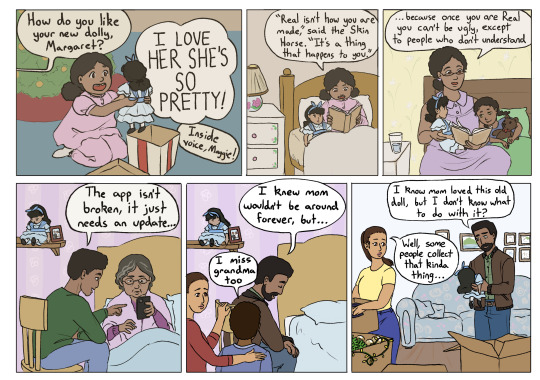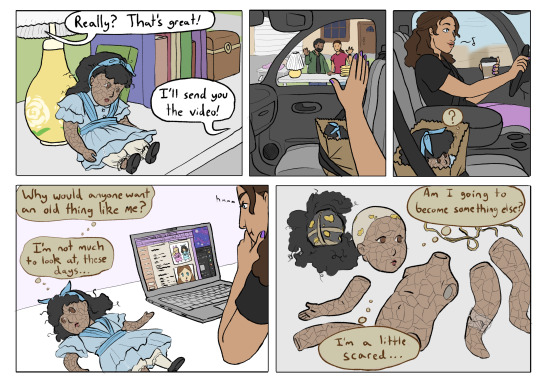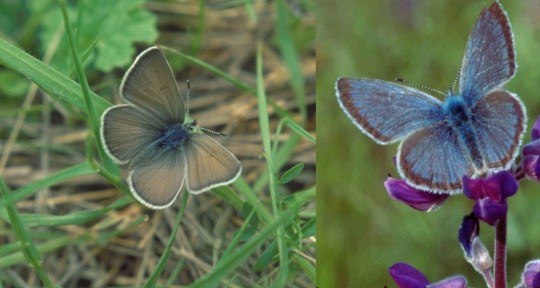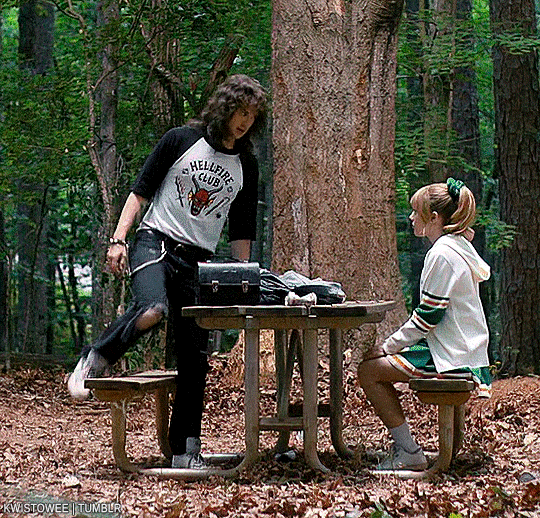#for restoration
Text
“Good luck. And DON’T fuck it up.”

#just to clarify I didn’t make this edit. this is an old tumblr post that the website made inaccessible for some reason. so I recreated it#it’s smth of a historic restoration effort with saw heritage posts. check their addition (also part of the original post)#loutown#saw
36K notes
·
View notes
Text



I meant to draw this back when I did this other doll comic as another side, to show a doll that had been cared for instead of abused, but somehow I wasn't able to finish it till like 10 minutes ago, anyway I did it *confetti*
#nardacci art#doll restoration#comic#I had the thumbnail sketches for the panel layouts in my files for like years#I've had the notes on my desktop since uuuhhh#wow 2020 I guess????? that's when I posted the cursed doll comic OTL#I have 1 more to do so maybe I'll get that one done by 20 freaking 28
19K notes
·
View notes
Photo

Nightclub singer at home, ca. 1960s
12K notes
·
View notes
Text
"A federal district court recently ruled that a large portion of Electron Dam must be removed from the Puyallup River in Washington because the dam harms fish protected under the Endangered Species Act.
Electron Dam has been harming Chinook salmon, steelhead, and trout for nearly 100 years. In 2020, the company that operates the dam tried to replace a spillway and botched the job, creating more hazards for the fish. Earthjustice went to court to press for the new segment’s removal on behalf of the Puyallup Tribe. Salmon and other native fish play a critical role in the Tribe’s culture and economy. With this part of the dam gone, the river will flow naturally for the first time in almost a century."
5K notes
·
View notes
Text

#skin is clear?? mood is lifted??? happiness is restored??#good omens#good omens s3#good omens season 3#foolish talks
5K notes
·
View notes
Text
In the Willamette Valley of Oregon, the long study of a butterfly once thought extinct has led to a chain reaction of conservation in a long-cultivated region.
The conservation work, along with helping other species, has been so successful that the Fender’s blue butterfly is slated to be downlisted from Endangered to Threatened on the Endangered Species List—only the second time an insect has made such a recovery.
[Note: "the second time" is as of the article publication in November 2022.]
To live out its nectar-drinking existence in the upland prairie ecosystem in northwest Oregon, Fender’s blue relies on the help of other species, including humans, but also ants, and a particular species of lupine.
After Fender’s blue was rediscovered in the 1980s, 50 years after being declared extinct, scientists realized that the net had to be cast wide to ensure its continued survival; work which is now restoring these upland ecosystems to their pre-colonial state, welcoming indigenous knowledge back onto the land, and spreading the Kincaid lupine around the Willamette Valley.
First collected in 1929 [more like "first formally documented by Western scientists"], Fender’s blue disappeared for decades. By the time it was rediscovered only 3,400 or so were estimated to exist, while much of the Willamette Valley that was its home had been turned over to farming on the lowland prairie, and grazing on the slopes and buttes.

Pictured: Female and male Fender’s blue butterflies.
Now its numbers have quadrupled, largely due to a recovery plan enacted by the Fish and Wildlife Service that targeted the revival at scale of Kincaid’s lupine, a perennial flower of equal rarity. Grown en-masse by inmates of correctional facility programs that teach green-thumb skills for when they rejoin society, these finicky flowers have also exploded in numbers.
[Note: Okay, I looked it up, and this is NOT a new kind of shitty greenwashing prison labor. This is in partnership with the Sustainability in Prisons Project, which honestly sounds like pretty good/genuine organization/program to me. These programs specifically offer incarcerated people college credits and professional training/certifications, and many of the courses are written and/or taught by incarcerated individuals, in addition to the substantial mental health benefits (see x, x, x) associated with contact with nature.]
The lupines needed the kind of upland prairie that’s now hard to find in the valley where they once flourished because of the native Kalapuya people’s regular cultural burning of the meadows.
While it sounds counterintuitive to burn a meadow to increase numbers of flowers and butterflies, grasses and forbs [a.k.a. herbs] become too dense in the absence of such disturbances, while their fine soil building eventually creates ideal terrain for woody shrubs, trees, and thus the end of the grassland altogether.
Fender’s blue caterpillars produce a little bit of nectar, which nearby ants eat. This has led over evolutionary time to a co-dependent relationship, where the ants actively protect the caterpillars. High grasses and woody shrubs however prevent the ants from finding the caterpillars, who are then preyed on by other insects.
Now the Confederated Tribes of Grand Ronde are being welcomed back onto these prairie landscapes to apply their [traditional burning practices], after the FWS discovered that actively managing the grasslands by removing invasive species and keeping the grass short allowed the lupines to flourish.
By restoring the lupines with sweat and fire, the butterflies have returned. There are now more than 10,000 found on the buttes of the Willamette Valley."
-via Good News Network, November 28, 2022
#butterflies#butterfly#endangered species#conservation#ecosystem restoration#ecosystem#ecology#environment#older news but still v relevant!#fire#fire ecology#indigenous#traditional knowledge#indigenous knowledge#lupine#wild flowers#plants#botany#lepidoptera#lepidopterology#entomology#insects#good news#hope
4K notes
·
View notes
Text

it will take some time
#Harrow was right for putting cloth into Ianthe's mouth when restoring her arm#the locked tomb#gideon nav#kiriona gaia#harrowhark nonagesimus#griddlehark#gideon the ninth#gideon the ninth spoilers#harrow the ninth#harrow the ninth spoilers#nona the ninth#nona the ninth spoilers#art
6K notes
·
View notes
Text




ugh... this sceeeeeeene 🥰
STRANGER THINGS | 4.01
#eddie munson#eddiemunsonedit#joseph quinn#josephquinnedit#jqedit#chrissy cunningham#grace van dien#hellcheeredit#hellcheersource#strangerthingsedit#hellcheer#eddie x chrissy#stranger things#userrobin#anztag#userridge#userallisyn#cinemapix#filmtvcentral#my*gifs#userthing#mediagifs#tvedit#color correcting my gifs (for days on end) in ways no one else will notice but i will#and having done so will make me happier every time i see them.#restoring his leather jacket and jeans to true black makes me happy
2K notes
·
View notes
Text
"we bought this Victorian house and opened up the interior, adding lots of overhead lights and pewter walls-"
biting you killing you biting you killing you biting you killing you
#JUST BUY A NEW HOUSE#THAT IS NOT MAKING IT LIVABLE WHICH I WOULD UNDERSTAND. THAT IS RUINING IT.#IF NOT WANT OLD HOUSE. DO NOT BUY OLD HOUSE#and don't come at me with 'well some people can't afford restoration so!'#if you can't afford restoration you can't afford to completely redo the interior. IKEAfication costs money too#it's not the poor doing this. it's rich assholes. sometimes just developers even who don't intend to live there
5K notes
·
View notes
Text
If you aren't following the news here in the Pacific Northwest, this is a very, very big deal. Our native salmon numbers have been plummeting over the past century and change. First it was due to overfishing by commercial canneries, then the dams went in and slowed the rivers down and blocked the salmons' migratory paths. More recently climate change is warming the water even more than the slower river flows have, and salmon can easily die of overheating in temperatures we would consider comfortable.
Removing the dams will allow the Klamath River and its tributaries to return to their natural states, making them more hospitable to salmon and other native wildlife (the reservoirs created by the dams were full of non-native fish stocked there over the years.) Not only will this help the salmon thrive, but it makes the entire ecosystem in the region more resilient. The nutrients that salmon bring back from their years in the ocean, stored within their flesh and bones, works its way through the surrounding forest and can be traced in plants several miles from the river.
This is also a victory for the Yurok, Karuk, and other indigenous people who have relied on the Klamath for many generations. The salmon aren't just a crucial source of food, but also deeply ingrained in indigenous cultures. It's a small step toward righting one of the many wrongs that indigenous people in the Americas have suffered for centuries.
#salmon#dam removal#fish#animals#wildlife#dams#Klamath River#Klamath dams#restoration ecology#indigenous rights#Yurok Tribe#Karuk Tribe#nature#ecology#environment#conservation#PNW#Pacific Northwest
12K notes
·
View notes
Text


i will shove that crusty old titan back into tartarus myself to keep her happy
#hades#hades game#hades supergiant#hades 2#hades 2 spoilers#just in case#i start tearing up every time i think about her not knowing her family#and everyone in the underworld who must have celebrated her#and her growing up with an idea of them and a duty to restore her house#chronos you better watch your back#melinoë supergiant
2K notes
·
View notes
Text

Finally: The Official DBHC Etho Reference Sheet!
I had to clarify that the “current” look is for Season 9, because I’m not sure how or if he’ll change for s10 yet! The “current” version is essentially his updated “default” look! Thought I might mention also that “Back Around” on the loose timeline lineup at the bottom is a reference to a song on his playlist in which he takes some time away from everyone after re-deviating to re-remember and find himself <3
Side note: Etho wears his mask under his chin mostly just around bdubs, but he starts wearing it down more often around doc, tango, or others who are used to seeing the damage. More than anything else, he’s sure to keep it for protection purposes when he’s outside working, exploring, or anything else that isn’t just hanging and chatting with friends :]
#dbhc ref#I’ll be putting all of the official character references and the Android guide under that tag btw!#dbhc#dbhc etho#dbhc art#ethoslab#hermitcraft au#hermitcraft#hermitcraft dbh au#etho#art escapades#VERY EXCITED TO SHARE THIS#this had been sitting in my folders finished for a while but I had to add a bunch of little notes that I forgot to initially!!!#IT WAS WILD DRAWING PRE-DEVIANT ETHO AGAIN THOUGH I miss him#not really but. yknow#I might make a note later about little changes that happen after destruction because I imagine doc and xisuma try very hard to#restore the cracks as close as they can but it’s not Perfect#BUT ANYWAY#YIPPE ETHO REF SHEET#character ref sheet#Android etho
1K notes
·
View notes
Photo

Showgirls Play Chess Backstage at the Latin Quarter Nightclub
Gordon Parks, “The Girls Backstage,” Life, Dec 22, 1958
#showgirl#1950s#life magazine#gordon parks#1950s fashion#vintage#50s#50s fashion#vintage fashion#latin quarter#nightclub#chess#new york#photography#photo restoration
5K notes
·
View notes
Text

Maru on her day off, working in the lab and part time at the clinic.
#doodle#stardew valley#stardew valley maru#sdv maru#she’s a busy gal#how des she do it????#on the top left in her jumpsuit I like to think she’s be lending Sebastian a hand restoring his motorcycle#let me have sibling bonding time!!!#also i didnt want her to draw her wearing a lab coat just because I already drew Harvey wearing one lmao#also i based her nurse uniform on filipino nurse uniform#but also i’d like to think harvey isnt that strict with hair style unless Maru has to directly help with a patient#JUST LET ME DRAW HER WITH CURLY HAIR OK
5K notes
·
View notes
Text

I love love LOVE all the expressions Eddie has during the Homewarming special!!! He makes such nice faces while experiencing The Horrors I had to redraw some for myself!!- Sweat on fleecy-skin is such an odd thing!
Everything from this update has been wonderful!!! Full Congrats to Clown and the people behind Welcome Home on everything they've made!! It's all wonderful!!!
#art#illustration#digital art#my art#welcome home#welcomehome#welcome home update#welcome home update spoilers#welcome home spoilers#eddie dear#welcome home eddie#welcome home eddie dear#welcome home restoration project#welcome home restoration project spoilers
1K notes
·
View notes
Text
The Klamath River’s salmon population has declined due to myriad factors, but the biggest culprit is believed to be a series of dams built along the river from 1918 to 1962, cutting off fish migration routes.
Now, after decades of Indigenous advocacy, four of the structures are being demolished as part of the largest dam removal project in United States history. In November, crews finished removing the first of the four dams as part of a push to restore 644 kilometres (400 miles) of fish habitat.
“Dam removal is the largest single step that we can take to restore the Klamath River ecosystem,” [Barry McCovey, a member of the Yurok Tribe and director of tribal fisheries,] told Al Jazeera. “We’re going to see benefits to the ecosystem and then, in turn, to the fishery for decades and decades to come.” ...
A ‘watershed moment’
Four years later, [after a catastrophic fish die-off in 2002,] in 2006, the licence for the hydroelectric dams expired. That created an opportunity, according to Mark Bransom, CEO of the Klamath River Renewal Corporation (KRRC), a nonprofit founded to oversee the dam removals.
Standards for protecting fisheries had increased since the initial license was issued, and the utility company responsible for the dams faced a choice. It could either upgrade the dams at an economic loss or enter into a settlement agreement that would allow it to operate the dams until they could be demolished.
“A big driver was the economics — knowing that they would have to modify these facilities to bring them up to modern environmental standards,” Bransom explained. “And the economics just didn’t pencil out.”
The utility company chose the settlement. In 2016, the KRRC was created to work with the state governments of California and Oregon to demolish the dams.
Final approval for the deal came in 2022, in what Bransom remembers as a “watershed moment”.
Regulators at the Federal Energy Regulatory Commission (FERC) voted unanimously to tear down the dams, citing the benefit to the environment as well as to Indigenous tribes...
Tears of joy
Destruction of the first dam — the smallest, known as Copco 2 — began in June, with heavy machinery like excavators tearing down its concrete walls.
[Amy Cordalis, a Yurok Tribe member, fisherwoman and lawyer for the tribe,] was present for the start of the destruction. Bransom had invited her and fellow KRRC board members to visit the bend in the Klamath River where Copco 2 was being removed. She remembers taking his hand as they walked along a gravel ridge towards the water, a vein of blue nestled amid rolling hills.
“And then, there it was,” Cordalis said. “Or there it wasn’t. The dam was gone.”
For the first time in a century, water flowed freely through that area of the river. Cordalis felt like she was seeing her homelands restored.
Tears of joy began to roll down her cheeks. “I just cried so hard because it was so beautiful.”
The experience was also “profound” for Bransom. “It really was literally a jolt of energy that flowed through us,” he said, calling the visit “perhaps one of the most touching, most moving moments in my entire life”.
Demolition on Copco 2 was completed in November, with work starting on the other three dams. The entire project is scheduled to wrap in late 2024.
[A resilient river]
But experts like McCovey say major hurdles remain to restoring the river’s historic salmon population.
Climate change is warming the water. Wildfires and flash floods are contaminating the river with debris. And tiny particles from rubber vehicle tires are washing off roadways and into waterways, where their chemicals can kill fish within hours.
McCovey, however, is optimistic that the dam demolitions will help the river become more resilient.
“Dam removal is one of the best things we can do to help the Klamath basin be ready to handle climate change,” McCovey explained. He added that the river’s uninterrupted flow will also help flush out sediment and improve water quality.
The removal project is not the solution to all the river’s woes, but McCovey believes it’s a start — a step towards rebuilding the reciprocal relationship between the waterway and the Indigenous people who rely on it.
“We do a little bit of work, and then we start to see more salmon, and then maybe we get to eat more salmon, and that starts to help our people heal a little bit,” McCovey said. “And once we start healing, then we’re in a place where we can start to help the ecosystem a little bit more.”"
-via Al Jazeera, December 4, 2023
#indigenous#river#riverine#ecosystem#ecosystem restoration#klamath#klamath river#oregon#california#yurok#fishing#fisheries#nature is healing#literally this time lol#united states#dam removal#climate change#conservation#sustainability#salmon#salmon run#water quality#good news#hope#rewilding#ecology#environment
5K notes
·
View notes